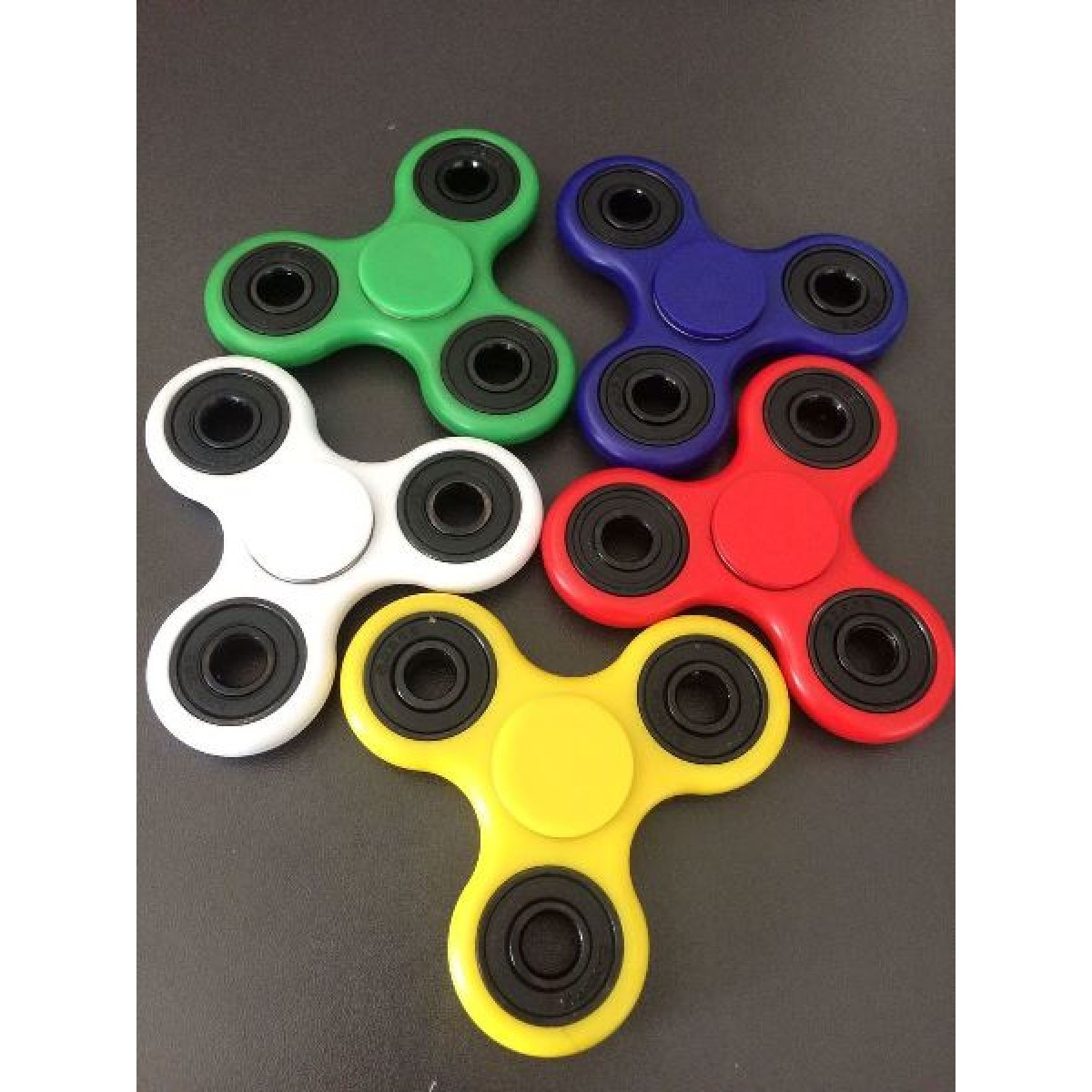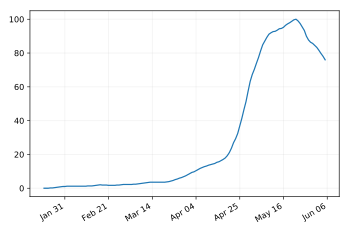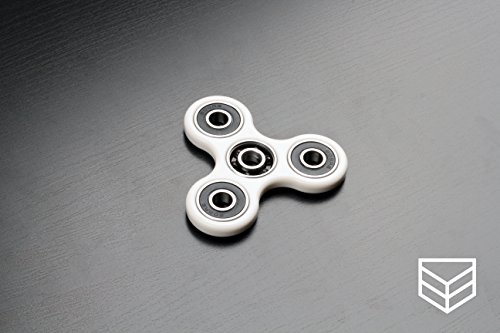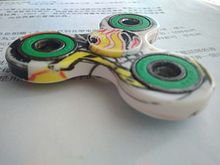Fidget Spinners
A fidget spinner is a toy that is marketed as relieving stress. It consists of a bearing in the center of a multi-lobed flat structure made from metal or plastic. The toy has been advertised as helping people who have trouble with focusing or fidgeting (such as those with ADHD, autism, or anxiety) by acting as a release mechanism for nervous energy or psychological stress. Experts are divided, with some supporting this claim and others disputing its scientific basis, arguing that the toy may be distracting.
Fidget spinners became popular toys in 2017, although similar devices had already been invented in 1993. Often marketed with claims of health benefits, the toy became popular among schoolchildren. Some schools banned the spinners for being a distraction, while other schools allowed the toy to be used discreetly.
Fidget spinners are designed to be used to relieve stress.[1][2] Basic fidget spinners consist of a two or three pronged design with a bearing in its center circular pad.[2][3] An individual holds the center pad while the toy spins.[3] Designs are made from various materials including brass, stainless steel, titanium, copper, aluminium, and plastic.[1][2][4] The types of bearings generally used are ceramic, metal (stainless steel or chrome), and hybrid designs. Each fidget spinner also has 2+ weights on the outside that allow it to spin faster and to stay balanced. Additionally, bearings can be different to adjust for the design's spin time, vibration, and noise, leading to unique sensory feedback.
![41lUdTGhLuL.jpg]

Catherine Hettinger, a chemical engineer by training, was initially credited by some news stories to have been the inventor of the fidget spinner, including by media outlets such as The Guardian,[5] The New York Times,[6] and the New York Post.[7] Hettinger filed a patent application for a "spinning toy" in 1993.[8] Hettinger told the New York Post that the idea for the toy came as she saw young boys throwing rocks at police officers in Israel. In response to seeing that, she wanted to develop a soothing toy that could help children release pent-up energy and "promote peace."[7] However, she told The Guardian that the origins of the fidget spinner came when she was suffering from myasthenia gravis, an autoimmune disorder that causes muscle weakness.[5] Unable to play with her daughter, she started "throwing things together with newspaper and tape" in an effort to entertain her. It soon gained moderate popularity as she began small-scale manufacturing from her home and sold her invention around art fairs in Florida.[5]
Hettinger applied for a patent on May 28, 1993 for a one-piece round device made of "soft plastic" with a "dome" (center indentation for finger placement) and a "skirt" (circular outward extension),[8] then pitched her spinner device to toy manufacturers. However, Hasbro declined to pursue a deal after market-testing it.[5] Hettinger let her spinning toy patent lapse in 2005; if it had been maintained, it would have expired in 2014.[9]
A Bloomberg News article, however, disputes the claim that Hettinger is the original inventor of the fidget spinner, citing two patent lawyers who saw little resemblance between the fidget spinners which rose to popularity in 2017 and Hettinger's spinning toy, as described in the patent. Hettinger acknowledges there is no direct connection between her own spinning toy and fidget spinners in their current form and does not make any claims on being the inventor of the product, telling Bloomberg News: "Let's just say I'm claimed to be the inventor. You know, 'Wikipedia claims', or something like that."[9]
Although the patent status of the various fidget spinners currently on the market is unclear,[9] in an interview appearing on May 4, 2017 on NPR, Scott McCoskery describes how he invented a metal spinning device in 2014 to cope with his own fidgeting in IT meetings and conference calls.[10] In response to requests from an online community, he began selling the device he called the Torqbar online.[10] Shortly thereafter, others began making and selling their own versions, and in 2016 he partnered with a friend to file for a provisional patent.[10]
On December 23, 2016, James Plafke of Forbes published an article describing fidget spinners as the "must-have office toy for 2017."[4] In late March, users on social media websites such as YouTube and Reddit began uploading videos reviewing and performing tricks with fidget spinners.[6][11] The Boston Globe reported that fidget toys in general "entered the mainstream" with the related Fidget Cube toy also rising in popularity.[1] Several sellers on Etsy were reported to be creating and selling customized spinner designs.[1]

The fidget spinner's popularity began to increase greatly in April 2017, with Google searches for "fidget spinner" spiking that month, according to Money magazine.[12][13] By May 4, variations of the spinner occupied every spot on Amazon's top 20 best seller list for toys.[12] Many publications referred to the fidget spinner as a fad, with some journalists comparing it to the rise in popularity of water bottle flipping in 2016.[14][15] On April 27, 2017, the New York Post detailed, "so-called fidget spinners, low-tech, low-price stress relieving toys, are a huge fad sweeping the country, and stores can't keep them in stock."[14] In May 2017, there was so much demand for fidget spinners that in China, some factories that used to make cellphones and phone accessories switched to making fidget spinners.[16] On May 16, 2017, video game publisher Ketchapp released a fidget spinner app. The app received 7 million downloads in the first two weeks after it was released.[17]
A June 16 article on FiveThirtyEight declared that "fidget spinners are over", based on a decline from mid-May to mid-June in Google News searches, web searches and YouTube searches, combined with the number of fidget spinner videos in YouTube's top daily trending list leveling off in the US.[18]

With the rapid increase in the spinner's popularity in 2017 — combined with the spinner's often advertised benefits for individuals with ADHD and autism, among other conditions — many children and teenagers began using it in school.[19] Some schools also reported that kids were trading and selling the spinner toys.[12][20] The Boston Globe cited a sixth-grade teacher from New Hampshire, who stated, "when we got back from Christmas break, a couple of kids had them, then a couple more kids had them, and then they were definitely en vogue."[1] In some cases, the fidget spinners were reported to assist some children with focusing in school.[21] In regards to a broader context of fidget tools in general, the Chicago Tribune reported, "today, it's common to see kids using some kind of fidget or other tool to help them settle and focus."[19]
As a result of their frequent usage by school children, many school districts have banned the toy.[5][6][22] Cited reasons for their banning were often teachers arguing that the spinners distracted students from completing their school work.[12] Taylor-Klaus stated, "there are definitely times that kids don't know how to use a fidget and it becomes the primary focus instead of the background focus", adding that, "spinners are visually distracting, and they can make some noise, so it's not an ideal fidget for the classroom. But still, not allowing them in schools is probably throwing the baby out with the bath water."[22] Illinois' Plainfield District 202 discussed possibly banning the spinner, with the district's assistant superintendent for student services, Mina Griffith, stating, "We have students who use them as an accommodation. They've been taught how to use them. But they're becoming a distraction for some kids. For students who don't have a disability, it's a toy, and that's never been allowed."[19] According to a study from the fidget spinner database Spinner List, 32% of the top 200 American high schools — the 100 largest private and 100 largest public schools, according to Department of Education data — have banned spinners from the premises.[23]
When fidget spinners rose in popularity in 2017, many publications discussed their claimed benefits for individuals with ADHD, autism, or anxiety.[26] As Money detailed, fidget spinners were "created and marketed as a calming tool used to stay focused."[12] Some fidget spinners sold on Amazon were advertised as "stress relievers."[24] Hettinger accounted her knowledge of "a special needs teacher who used it with autistic kids, and it really helped to calm them down."[5] James Plafke of Forbes explained, "ultimately, though, there isn't enough research regarding whether or not these spinners can actually help people from a mental health standpoint."[4] Experts themselves were polarized on this claim, as some supported the notion of its benefit for those with ADHD and autism,[27] while others argued the spinners could actually be more distracting than helpful with focusing.[28][29]

When reporting on their effects for individuals with ADHD, CNN cited Elaine Taylor-Klaus, the co-founder of ImpactADHD, a coaching service for children with attention disorders and their parents.[22] Taylor-Klaus stated "For some people [with ADHD], there's a need for constant stimulation. What a fidget allows some people — not all people — with ADHD to do is to focus their attention on what they want to focus on, because there's sort of a background motion that's occupying that need."[22] U.S. News & World Report referenced two occupation therapists interviewed by WTOP, Katherine Ross-Keller and Stephen Poss.[24][30] Ross-Keller stated, "Fidgets are great tools for kids who need them, as long as there are ground rules set up with the child and educator in advance, and as long as the child can follow the rules." Poss offered a more critical view of the spinners, "the spinner toys, in my opinion, and that of teachers I've spoken to, are just that — toys," adding, "fidget objects are meant to be felt, so that visual attention can be focused on the teacher. Spinner toys are visually distracting, and I think that's their major drawback."[24]